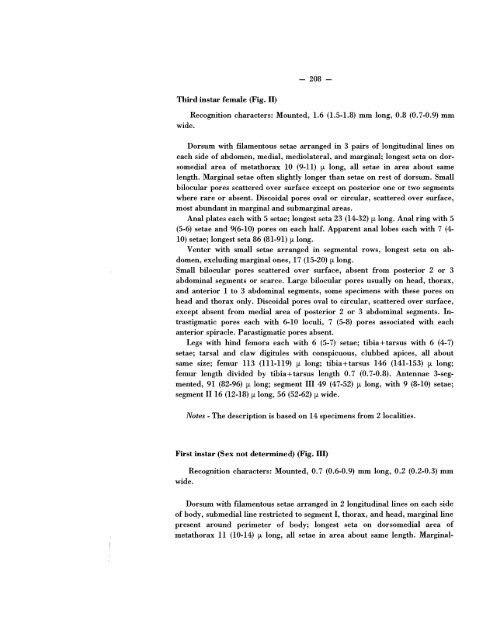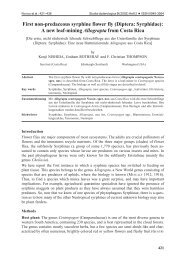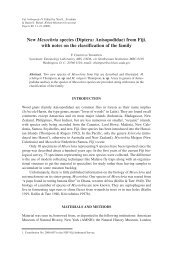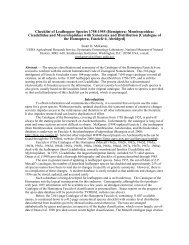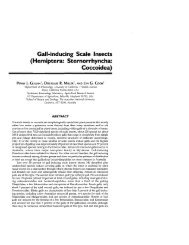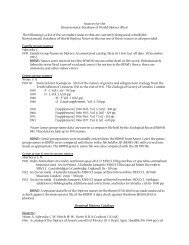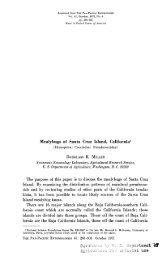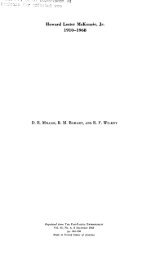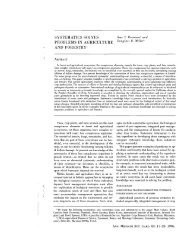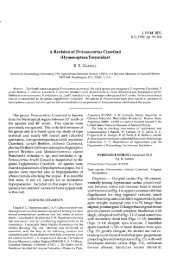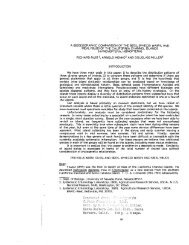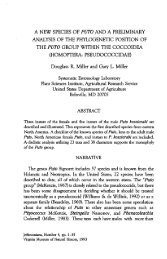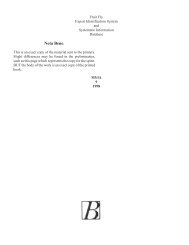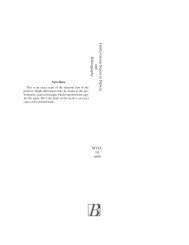Systematic revision of the Family Micrococcidae (Homoptera ...
Systematic revision of the Family Micrococcidae (Homoptera ...
Systematic revision of the Family Micrococcidae (Homoptera ...
You also want an ePaper? Increase the reach of your titles
YUMPU automatically turns print PDFs into web optimized ePapers that Google loves.
- 208 <br />
Third instar female (Fig. II)<br />
Recognition characters: Mounted, 1.6 (1.5-1.8) mm long, 0.8 (0.7-0.9) mm<br />
wide.<br />
Dorsum with filamentous setae arranged in 3 pairs <strong>of</strong> longitudinal lines on<br />
each side <strong>of</strong> abdomen, medial, mediolateral, and marginal; longest seta on dorsomedial<br />
area <strong>of</strong> metathorax 10 (9-11) fl long, all setae in area about same<br />
length. Marginal setae <strong>of</strong>ten slightly longer than setae on rest <strong>of</strong> dorsum. Small<br />
bilocular pores scattered over surface except on posterior one or two segments<br />
where rare or absent. Discoidal pores oval or circular, scattered over surface,<br />
most abundant in marginal and submarginal areas.<br />
Anal plates each with 5 setae; longest seta 23 (14-32) fllong. Anal ring with 5<br />
(5-6) setae and 9(6-10) pores on each half. Apparent anal lobes each with 7 (4<br />
10) setae; longest seta 86 (81-91) fllong.<br />
Venter with small setae arranged in segmental rows, longest seta on abdomen,<br />
excluding marginal ones, 17 (15-20) fllong.<br />
Small bilocular pores scattered over surface, absent from posterior 2 or 3<br />
abdominal segments or scarce. Large bilocular pores usually on head, thorax,<br />
and anterior 1 to 3 abdominal segments, some specimens with <strong>the</strong>se pores on<br />
head and thorax only. Discoidal pores oval to circular, scattered over surface,<br />
except absent from medial area <strong>of</strong> posterior 2 or 3 abdominal segments. Intrastigmatic<br />
pores each with 6-10 loculi, 7 (5-8) pores associated with each<br />
anterior spiracle. Parastigmatic pores absent.<br />
Legs with hind femora each with 6 (5-7) setae; tibia +tarsus with 6 (4-7)<br />
setae; tarsal and claw digitules with conspicuous, clubbed apices, all about<br />
same size; femur 113 (111-119) fl long; tibia+tarsus 146 (141-153) fl long;<br />
femur length divided by tibia +tarsus length 0.7 (0.7-0.8). Antennae 3-segmented,<br />
91 (82-96) fl long; segment III 49 (47-52) fl long, with 9 (8-10) setae;<br />
segment II 16 (12-18) fllong, 56 (52-62) fl wide.<br />
Notes - The description is based on 14 specimens from 2 localities.<br />
First instar (Sex not determined) (Fig. III)<br />
Recognition characters: Mounted, 0.7 (0.6-0.9) mm long, 0.2 (0.2-0.3) mm<br />
wide.<br />
Dorsum with filamentous setae arranged in 2 longitudinal lines on each side<br />
<strong>of</strong> body, submedial line restricted to segment I, thorax, and head, marginal line<br />
present around perimeter <strong>of</strong> body; longest seta on dorsomedial area <strong>of</strong><br />
metathorax 11 (10-14) fl long, all setae in area about same length. Marginal


